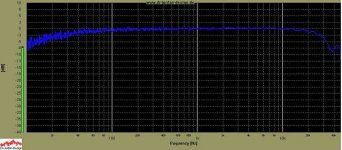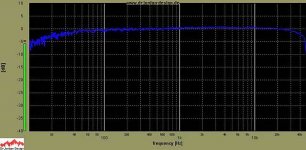Transcendar
Transcendar makes transformers and chokes for medium production run purchases. They make many types, including custom designs for particular vendors, so it is hard to make a blanket statement about the applicability of your transformers. However, their build quality is very good, and my experience with them (sonically) has been good.
- John Atwood
Transcendar makes transformers and chokes for medium production run purchases. They make many types, including custom designs for particular vendors, so it is hard to make a blanket statement about the applicability of your transformers. However, their build quality is very good, and my experience with them (sonically) has been good.
- John Atwood
If you are referring to the "output transformers for 300B amplifiers" that he sells on Ebay, yes I tested them against a One Electron UBT-3 and a custom Electra-Print. Most listeners could not tell the difference between the UBT-3 and the Transcendar. Most listeners could pick out the Electra-Print although one person consistently said thet it sounded worse than the other two. I liked the Transcendars enough to buy 10 pairs. Most of them have been used in my TubelabSE 300B amplifiers which have found new homes with happy owners.
I don't think that you could do any better in this price range.
I have a budget transformer test page that should be on my web site by the end of the weekend. I don't have frequency response plots for the trancendars yet, they will be added when I do them.
http://www.tubelab.com/BudgetOPT.htm
The page is not done yet, I will update it Sunday evening.
I don't think that you could do any better in this price range.
I have a budget transformer test page that should be on my web site by the end of the weekend. I don't have frequency response plots for the trancendars yet, they will be added when I do them.
http://www.tubelab.com/BudgetOPT.htm
The page is not done yet, I will update it Sunday evening.
I'll second tubelab's comments on the Transcendar 300B output transformer. I used a pair in a 2A3 amplifier I designed recently and they really are very good sounding transformers, and an absolute steal at the price - at twice the price I would still say the same.
Highly recommended!
Highly recommended!
Tonight I wired a pair of these Transcendars into the simpleSE that I have been torturing for the last few weeks. It currently (today) has a pair of JJ EL34's running at 475 volts. A 3K ohm load would normally be a bit low for this much B+ voltage, but I connected the cathode feedback and cranked it up. These transformers respond well to cathode feedback. I have the tubes running in triode mode (no UL tap) and I am seeing peaks of at least 10 watts on the scope while playing a bass heavy CD. No clipping is observed, and they sound really good. The tubes do not appear upset at this torture either. Transients like the snare drum, cymbals, and finger cymbals have startling realism. Overall the bass just blows away my 300B amp that is running the same transformers!
I am going to plug in some 6L6's and test further.
I am going to plug in some 6L6's and test further.
I haven't had time to run a frequency response plot yet. I ran one back when I got the transformers, but I lost it when my hard drive died. I think they were flat to 20 KHZ and then rolled off rather quickly, but I could be remembering the wrong transformers. I have a few similar sized transformers lined up on the bench for testing, but I may not get to them this weekend. I am modifying the amp to make changing transformers easier. When I threw this prototype together I mounted everything to a piece of plywood. The sum of the parts that I have added to the amp (filter choke, big motor run cap, larger transformers) have outgrown the available space. We have also just been informed that my mother in law is on her way to visit. All of the junk that is in the spare bedroom will get shoved into my lab for 2 weeks.
When I laid out the PC board for my TubelabSE I didn't think of cathode feedback. Both 300B's are powered from the same DC filament supply. This connects their cathodes together, making cathode feedback impossible. The amp would also likely run short of gain if feedback is applied. Yes, it would probably improve the bass, and someday I will try it using external supplies.
When I laid out the PC board for my TubelabSE I didn't think of cathode feedback. Both 300B's are powered from the same DC filament supply. This connects their cathodes together, making cathode feedback impossible. The amp would also likely run short of gain if feedback is applied. Yes, it would probably improve the bass, and someday I will try it using external supplies.
For more info on this amp and a couple of pictures see:
http://www.diyaudio.com/forums/showthread.php?s=&threadid=74650
For some serious torture testing of a few output tubes see:
http://www.diyaudio.com/forums/showthread.php?s=&threadid=80701
http://www.diyaudio.com/forums/showthread.php?s=&threadid=74650
For some serious torture testing of a few output tubes see:
http://www.diyaudio.com/forums/showthread.php?s=&threadid=80701
I finally got around to running a frequency response test on the Transcendar transformer. The 3db points are 19.4 Hz and 29.0 KHz. The amp makes 5.3 watts continuous power at 5% distortion at 1KHz. Full power at 5% is available down to 48Hz. The maximum 5% power at 30 Hz is 3.92 watts. The maximum 5% power available at 20 KHz is 3.0 watts. This is fine for most music.
In the next post, I ran the same tests on the UBT-3 for comparisons. In previous listening tests these transformers sound similar. If you look at the data over the range occupied by most music, they test similar.
In the next post, I ran the same tests on the UBT-3 for comparisons. In previous listening tests these transformers sound similar. If you look at the data over the range occupied by most music, they test similar.
Attachments
I also ran a frequency response test on the One Electron UBT-3 transformer. The 3db points are 19.0 Hz and 44.1 KHz. The amp makes 5.12 watts continuous power at 5% distortion at 1KHz. Full power at 5% is available down to 42Hz. The maximum 5% power at 30 Hz is 3.0 watts. Full power is available to beyond 20 KHz.
Attachments
I tested the Electra-Prints in the past. The results are on the transfomer testing page on my web site. Many of these transformers were tested at different times, and under different conditions.
I have some Hammonds and Edcors on order, so I plan on testing them all again in the new SimpleSE test
amp.http://www.tubelab.com/BudgetOPT.htm
I have some Hammonds and Edcors on order, so I plan on testing them all again in the new SimpleSE test
amp.http://www.tubelab.com/BudgetOPT.htm
When i started this amp project i had no idea what the results would be as i was formally a solidstate man.
My amp uses the transformers discussed driven by some 1967 weco 300Bs which in turn are driven my some 1950's 6SN7s. Amp output drives full range 6 inch Fostex speakers. It is the best thing I have ever heard. My 280 watt SS amp now drives a subwoofer.
Thanks for all the help and info.
PH
My amp uses the transformers discussed driven by some 1967 weco 300Bs which in turn are driven my some 1950's 6SN7s. Amp output drives full range 6 inch Fostex speakers. It is the best thing I have ever heard. My 280 watt SS amp now drives a subwoofer.
Thanks for all the help and info.
PH
Personally, I like to get xfmrs that are good out past 75kHz, as far as possible past 75kHz. Now I know that iron with response just past or at 20kHz will "sound good" too, but keep in mind that the effect is to make everything that is close to 20kHz start to look rounded like a sinewave... which as I noted will almost always "sound good". Also there is an inevitable rolloff before 20kHz... which also can "sound good."
I am assuming no FB around the output iron... that will make things ring like a bell if you try to flatten the HF droop that way...
The Partridge designs had very wide bandwidth, and may be worth revisiting the articles in Wireless World to see the how and why of it...
There are other ways of making a wide bandwith output transformer too, but the Partridge embodies many key elements that are needed to do the job.
Iirc, many of the old Triad output irons had response out to 60kHz or more...
Just thinking out loud...
_-_-bear
I am assuming no FB around the output iron... that will make things ring like a bell if you try to flatten the HF droop that way...
The Partridge designs had very wide bandwidth, and may be worth revisiting the articles in Wireless World to see the how and why of it...
There are other ways of making a wide bandwith output transformer too, but the Partridge embodies many key elements that are needed to do the job.
Iirc, many of the old Triad output irons had response out to 60kHz or more...
Just thinking out loud...
_-_-bear
- Status
- This old topic is closed. If you want to reopen this topic, contact a moderator using the "Report Post" button.
- Home
- Amplifiers
- Tubes / Valves
- transcendar transformer

